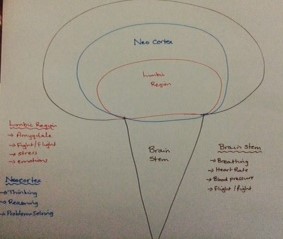Did you read yesterday’s post on the stress response? I know it was lengthy and a little technical, but if you haven’t read it, I’d encourage you to go back and do it, because today’s post will make much more sense if you have.
So yesterday we learned about how the brain processes stress. We looked at the 3 parts of the Triune Brain, as shown in my very artistic diagram.
And we discovered that little thing in the limbic region called the amygdala.
If you’d like to read more about the neuroscience of the amygdala try this site. It’s pretty technical but it shows how the different parts of the brain feed into the amygdala and how the amygdala feeds into other parts, which then impact on our emotions.
Remember, the amygdala has just one job of making the assessment about whether a situation is life threatening.
As I explained yesterday, when the answer is yes, the stress response is activated. And the amygdala is what we call “up-regulated”. Signals are sent to the brain stem to increase heart rate, breathing, blood pressure. They’re also sent to the neocortex to shut down the non-essential ability to think, reason and problem solve (see diagram above).
And by doing this we are able to respond effectively to the risk to our survival.
But what if we aren’t really at risk? Remember me saying yesterday that the amygdala can’t tell the difference between a saber-tooth tiger and finances? There really isn’t any bill on the planet, no matter how large, that threatens our existence. Promise.
So we’ve got this up-regulation going on, where our bodies are flooded with adrenalin and cortisol. We feel out of control, like nothing is going to go right. We have emotions galore running over us and through us. And all we can think about is the thing that activated the response in the first place. In this case, the bills.
Which is the other thing I neglected to mention yesterday. Part of the stress response is the complete focus on the thing that places us under threat. Do you think it would help us survive if we took our eyes off the tiger and forgot it was sitting on the rock? No way! It would immediately take its opportunity to pounce and attack. Kind of self-explanatory, right?
When it comes to the bills the reaction is the same. Our focus is complete. We worry, we mull it over, wonder what we are going to do. And because our neocortex isn’t working due to the lack of blood flow, we aren’t thinking clearly about it. We can’t problem solve it.
So we have a body full of adrenalin and cortisol, we feel antsy and restless, out of control, we have a racing heart and lots of muscle tension, and all we can think about is the bills (or whatever activated the response).
We need to find a way to reverse the process. To re-engage the neocortex so we can think and figure a way out of the situation. To calm our emotions, our heart rate. To ease the muscle tension and release the adrenalin and cortisol.
For such a complex system it feels like the solution needs to be just as complex, right? After all, this up-regulation feels completely horrid, so it must be complicated. Right?
Wrong.
The solution is so simple it seems like it won’t have any chance of working. Surprisingly though, it does.
I find that the simplest solutions work the best.
Breathing.
That’s it. Just breathe.


Comments on: "Stress and the amygdala" (7)
[…] I feel that the majority of it comes down to the neurobiological stress response that we have already discussed in several posts. We introduced it with Stress and the Triune Brain and continued it with Stress and the Amygdala. […]
LikeLike
I have been hijacked by the amygdala for years and it has taken me 10 years to implement breathing strategies because my first response was to dissociate. Now when I feel the hijack I place my hand gently on the chest and breathe, The touching the chest connects me back to my body so I can breathe.
LikeLiked by 1 person
That’s such a long time to have control of your own emotions removed from you. It’s great to know that you’ve learned a simple strategy for reconnecting to your body. When you use this breathing strategy are you breathing from the diaphragm? If not, try placing your hand on your ribcage to feel your tummy rising up as you inhale.
Keep an eye out on the blog later in the month as I am doing a post specifically on reconnecting to your mind and body as you calm the stress response.
I’m so glad you found The Mindset Effect blog!
Ali xx
LikeLike
[…] the response. Check out our previous posts over the last few days on Stress and the Triune Brain, Stress and the Amygdala, Stress and Trauma, and the down-regulation of stress. They will give you a good idea of how this […]
LikeLike
[…] a rock these past 19 days and haven’t read anything about it, you can find it in this post and this one. The impacts of stress on our systems are so huge and it’s really important that we are able to […]
LikeLike
[…] This controls our emotions. The amygdala lives in the limbic region and if you remember back to my previous post on this, its job is to make an assessment about whether your life is at threat. So when we perceive our […]
LikeLike
[…] you can go back and read any of those earlier posts on the Triune brain, trauma, hormones and the amygdala. Between them, they explain the workings of our inbuilt survival mechanism and why many of our […]
LikeLike